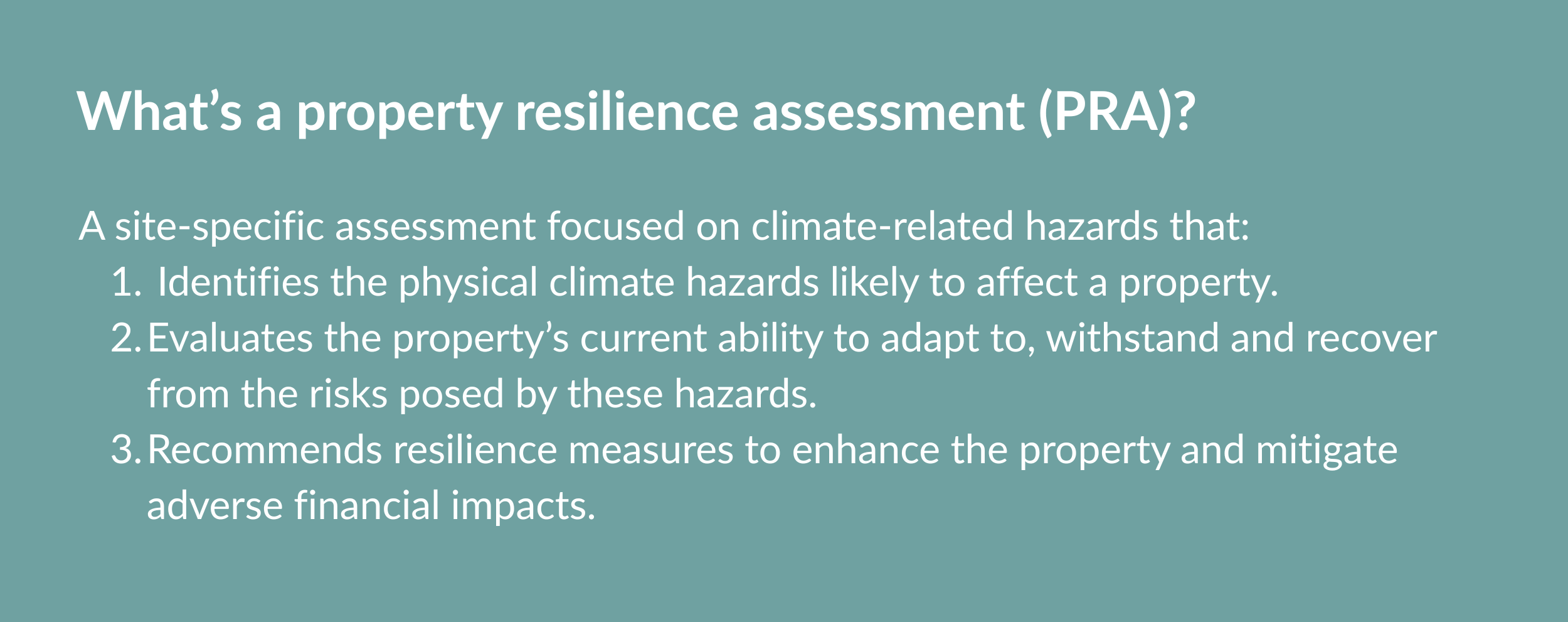Our industry is engaged in an important dialogue to improve the efficiency and resilience of real assets through transparency and industry collaboration. This article is a contribution to this larger conversation and does not necessarily reflect GRESB’s position.

Ask around in commercial real estate circles, and you’ll hear it: “Climate strategy” starts and ends with decarbonization. There are good reasons that work such as inventorying and reducing greenhouse gas (GHG) emissions—alternatively called mitigation, decarbonization, and transition planning—has dominated the conversation of late. It provides businesses with reputational currency today while also uncovering operational inefficiencies and supporting portfolio managers in strategically prioritizing assets for capital investment.
That said, decarbonization is only one side of the climate coin. The other—physical climate resilience—acknowledges that a changing climate is no longer a future, theoretical scenario. It’s a balance sheet issue, here and now. So why has resilience planning lagged behind decarbonization? We see the issue not as a lack of awareness but that resilience is harder to measure, less standardized, and rarely integrated into the same workflows as carbon planning. This disconnect carries significant financial risks: unplanned downtime, emergency response, catastrophic damages, and/or a sudden jump in insurance premiums can threaten cash flow, asset value, or even solvency.
Resilience and the business case for real estate
Making the business case for climate investments has never been easy, and resilience is no exception. This work is complex. It cuts across departments, challenges existing workflows, and resists simple ROI calculations. Done right, integrated resilience and decarbonization planning touches the core of how a business operates—how it prioritizes assets, allocates capital, manages risk, and creates long-term value.
According to the National Institute of Building Sciences, every USD 1 spent on mitigation saves USD 13.
Recently, the conversation has started to change. CRE is already feeling the financial impacts of climate change: volatile energy costs, building performance compliance risks, rising insurance rates, and higher transaction costs. The good news for those seeking to advance climate initiatives is that many organizations now have demonstrated quantifiable financial impacts to build internal alignment around the importance of investing in decarbonization and resilience. As budgets grow, so does the need to invest wisely—by aligning decarbonization and resilience to maximize impact and protect long-term value.
Integrating resilience and decarbonization at transaction
Let’s look at how integrating decarbonization and resilience brings synergies to common real estate activities. Take Property Condition Assessments (PCA), for example—a standard part of valuation and due diligence. A PCA provides essential information on building systems, structure, and site conditions. It will not tell you how those systems are likely to perform under stress from hazards like flooding, extreme heat, or smoke pollution. It also won’t capture building energy performance, future compliance risk, or the financial impact of delayed upgrades. To be fair, you might get these in a separate energy audit or specialized property resilience assessment (PRA), though we don’t see these required in every transaction to the same extent as PCAs.

Many commercial real estate managers are now utilizing desktop climate risk assessments, which are helpful for identifying exposure to physical hazards and potentially ballparking financial impact (emphasis on “ballpark”). These assessments answer the question: What hazards might this property face? What desktop assessments generally won’t provide is investment-grade analysis of an individual property’s vulnerability (how likely a specific asset is to suffer actual damage or disruption), and that’s what ultimately drives financial outcomes.
By integrating condition, risk, and energy assessment, lenders, buyers, and anyone else relying on this data have comprehensive and quantifiable insight to inform valuations, negotiate accordingly, and optimize planning across both decarbonization and resilience upgrades. It can also help sellers who’ve already made resilience and decarbonization investments communicate asset value more clearly—especially when an asset may appear high-risk on paper but has low actual vulnerability thanks to smart interventions.
Designing smarter from day one
What about planning decarbonization and resilience for new builds? In many projects, decarbonization is now considered early in design—resilience, not so much. That gap leads to missed opportunities, retrofit costs, and, in some cases, buildings that meet performance goals but remain vulnerable to physical risk. Instead, resilience and decarbonization can be integrated from the start—at site selection, during material choices, and throughout system design. This upfront coordination helps avoid costly late-stage interventions, protects long-term asset value, and often leads to smarter capital allocation. It’s also increasingly reflected in standards like LEED v5, which explicitly incorporate physical risk and climate resilience alongside carbon metrics.
When planned together, resilience measures and decarbonization strategies can reinforce each other—not compete for budget. That’s where portfolio value is won or lost.
Act early. Invest wisely. Stay ready.
With climate risk already reshaping valuations, insurance markets, and operating costs today, there is an opportunity for commercial real estate owners and managers to make smart, integrated moves that create real business advantage. Making the most of this opportunity requires taking a systems approach—planning once, not twice. That means leveraging your data to the fullest by connecting disparate streams like energy use, GHG emissions, asset condition, and physical risk. It also means making every site visit count by evaluating assets holistically, not in silos. And it means looking for synergies, not tradeoffs—where decarbonization and resilience efforts reinforce one another rather than compete for capital.
Here are three ways to start:
- Integrate decarbonization and resilience into due diligence. When acquiring property, pair decarbonization assessments with site-specific Property Resilience Assessments (PRAs) to evaluate energy performance, regulatory risk, and vulnerability to physical hazards. For consistency and investment-grade rigor, reference the new ASTM PRA standard.
- Make resilience part of your carbon strategy. When setting emissions targets or planning capital upgrades, embed resilience from the start. For new developments, that means pairing early physical hazard assessments with iterative life cycle assessments (LCAs) and energy models during design. This holistic approach helps you optimize materials, systems, and site design for both performance and risk reduction. Design standards like LEED v5 are already moving this way—requiring climate risk assessments alongside carbon performance.
- Use data to your advantage with insurers. If premiums are climbing but your building is better protected than your underwriter knows, share PRA findings to advocate for more accurate risk pricing. Site-level insight can strengthen your case and potentially lower your rates.
Resilience and decarbonization don’t belong in separate plans—or separate teams. The most effective strategies bring together energy, operations, capital planning, and risk management to protect and grow asset value. That level of coordination takes upfront effort, but the payoff is real: fewer surprises, smarter investments, and stronger portfolios. For real estate leaders, the opportunity is clear: plan once, act strategically, and invest wisely.
References:
“‘You’ve Got a Physical Climate Risk Assessment…Now What?‘” Greenbuild Blog, Informa Connect. Accessed August 27, 2025.
“Billion-Dollar Weather and Climate Disasters.” National Centers for Environmental Information (NCEI), NOAA. Accessed August 27, 2025.
“Mitigation Saves: Mitigation Saves $13 per $1 Invested.” National Institute of Building Sciences, PreventionWeb. Accessed August 27, 2025.
This article was written by Colette Crouse, Senior Director, Carbon Services at Stok. Learn more about Stok here.